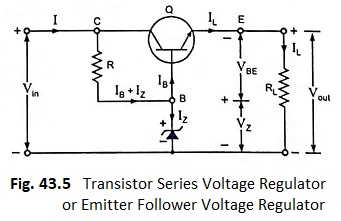Transistor Series Voltage Regulator or Emitter Follower Voltage Regulator:
A simple series voltage regulator using an NPN transistor and a zener diode is shown in Fig. 43.5. This circuit is called a series regulator because collector and emitter terminals of the transistor are in series with the load, as illustrated in the figure. This circuit is also called an emitter follower voltage regulator because transistor Q is connected in emitter follower configuration.
Here, the transistor Q is termed a series-pass transistor. The unregulated dc supply (or filtered output from the rectifier) is fed to the input terminals and regulated output voltage Vout is obtained across the load resistor RL. Zener diode provides the reference voltage and the transistor acts as a variable resistor, whose resistance varies with the operating conditions (base current IB). The principle of operation of such a regulator is based on the fact that a large proportion of the change in supply (or input) voltage appears across the transistor and, therefore output voltage tends to remain constant.
Keeping in mind the polarities of different voltages we have
The base voltage of the transistor remains almost constant being equal to that across the zener diode, VZ.
Operation:
(i) Let the supply (or input) voltage increase which will cause the output voltage Vout to increase. An increase in output voltage Vout will result in decrease of VBE because VZ is fixed and decrease in VBE will reduce the level of conduction. This will lead to increase in the collector-emitter resistance of the transistor causing an increase in collector to emitter voltage and as a result the output voltage will be reduced. Thus output voltage will remain constant. Similar explanation can be given for decrease in supply voltage.
(ii) Now let us consider the effect of change in load on the output voltage—say current is increased by decrease in RL. Under such a situation the output voltage Vout tends to fall and, therefore, VBE tends to increase. As a result the conduction level of the transistor will increase leading to decrease in the collector-emitter resistance. The decrease in the collector-emitter resistance of the transistor will cause the slight increase in input current to compensate for the decrease in RL. Thus the output voltage being equal to ILRL remains almost constant. Similar explanation will hold true for increase in RL.
The advantage of such a emitter follower voltage regulator circuit is that the changes in zener current are reduced by a factor β and thus zener effect is greatly reduced and much more stabilized output is obtained.
Output voltage from a series regulator, Vout = (VZ – VBE), and maximum load current IL(max can be the maximum emitter current that the transistor Q is capable of passing. For a 2N3055 transistor, load current IL could be 15 A. When load current IL is zero, the current drawn from the supply is approximately (IZ + IC (min)). The zener regulator (resistor R and zener diode form a simple zener regulator) has to supply only the base current of the transistor. The emitter follower voltage regulator is, therefore, much more efficient than a simple zener regulator.
Limitations of Emitter Follower Voltage Regulator:
- The output voltage cannot be maintained absolutely constant because both VBE and VZ decrease with the increase in room temperature. Further, VBE increases slightly with the increase in load.
- The output voltage cannot be changed as there is no provision for it in the circuit.
- It cannot provide good regulation at high currents because of small amplification provided by one transistor.
- It has poor regulation and ripple suppression with respect to input variations as compared to other regulators.
- The power dissipation of a pass transistor is large because it is equal to VCC IC and almost all variation appears at VCE and the load current is approximately equal to collector current. Thus for heavy load currents pass transistor has to dissipate a lot of power and, therefore, becomes hot.
Because of above limitations application of this regulator is limited to low output voltages.
